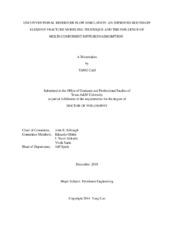| dc.description.abstract | The natural fractures and hydraulic fractures often form complex fracture network in shale
reservoirs, which poses great challenge to the flow simulation of such complex reservoirs. In this
study, a theoretically sound, and practically robust boundary element method (BEM) numerical
algorithm is developed and successfully implemented. Explicit and discrete fracture description
is adopted in this approach, and the complex fracture settings and interactions are effectively simulated.
Comparing with the domain discretization methods (e.g., finite element method (FEM),
finite difference method (FDM)), mesh generation is greatly simplified in our approach, especially
for reservoirs with complex fracture configurations. Case studies show: our algorithm is
capable of modeling two-dimensional (2D) steady state flow in fractured reservoirs with different
boundary conditions and complex fracture networks; also, the transient flow dynamics and the
flow dependence on matrix heterogeneity, which are seldom considered through a BEM approach,
are successfully accounted for; in addition, by characterizing the fracture flow using finite volume
element (FVM) formulation, the fluid flow in three-dimensional (3D) fractured reservoirs with
irregular fractures is properly handled through this algorithm.
Multiple porosity systems (especially organic matter) existing in shale reservoirs require a
reservoir simulator to properly account for the multi-component diffusion/adsorption phenomena
occurring in the matrix. A compositional model specifically tailored for the characteristics of shale
reservoirs is thus developed. The model takes the pressure and component molar masses as the
primary variables, and the IMPEM (implicit pressure and explicit mass) method as the solution
technique. The multi-component adsorption and diffusion influences are shown to be successfully
accounted for through this model. Case studies indicate: the multi-component adsorption which
mainly exists in the shale organic matter usually plays a positive role in shale reservoir recovery;
the influence of the different TOC values on shale fluid recovery may be different depending on
the fluid type and the operating conditions; and the multi-component diffusion facilitates the gas
recovery, yet the degree of this improvement differs for different wettability formations. | en |


